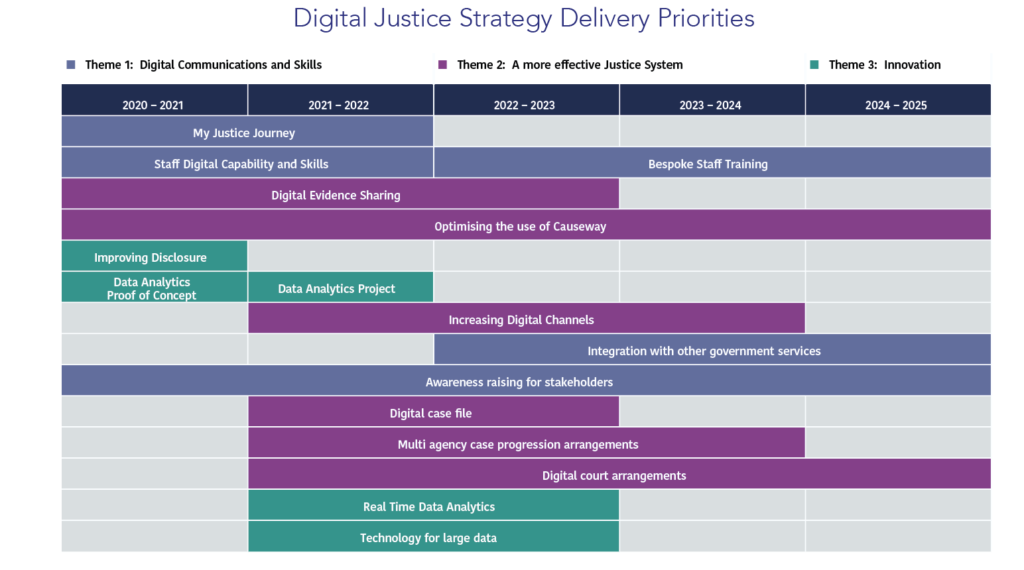Digital justice

Embedding digital and remote innovation necessitated in response to the pandemic will be a key element of progress under the new digital strategy.
Recent years have seen a number of significant digital developments across the justice sector, not least the introduction of technology into court rooms, in the form of videos, or in the PSNI, where body-worn cameras are now the norm across the service.
More fundamental system changes include the Legal Aid Management System (LAMS) launched in July 2019 and used by solicitors and barristers that deliver publicly funded legal services and the launch of STRmix™ by Forensic Science Northern Ireland, a major advance in DNA evidence usage.
However, recognition has been given to the need to further modernise justice and the potential of technology and digital solutions to tackle the long-term challenges of complex systems for victims, witnesses, defendants and their families. These cumbersome processes have often meant that the speed of justice has not met public expectations and led to poor collaboration across the justice sector.
The five-year Digital Justice Strategy was published in July 2020, containing three key principles that the strategy will seek to address in its lifespan, namely: citizen engagement; collaboration and modernisation.
Probably more importantly, though, the strategy recognises its overlap of Northern Ireland Assembly mandates and has therefore set targets to be initiated in the current mandate and longer-term goals on which some progress will have been initiated.
Much of the strategy was drafted prior to the outbreak of the pandemic but speaking recently in the Assembly, Justice Minister Naomi Long MLA said that while the pandemic has provided significant challenges across the court system and for all partners in the justice system, she believed the opportunities presented by the crisis in accelerating certain areas of digital justice are often overlooked.
“We have been working hard to ensure that the digital operation during the Covid crisis can be embedded in the system. Hopefully, we will be able to maintain much of the digital and remote working that we have been able to embed during the crisis. It will then provide further opportunities for flexibility,” she said.
Long also confirmed that “all six collaborative projects identified as delivery priorities for the first two years of the digital justice strategy 2020-2025 are under way and progressing well”, assessing that delivery of the strategy has already led to “tangible improvements”.
“I anticipate the further rollout of digital evidence-sharing within the next year across courts and with the legal profession,” the Minister added.
The strategy includes priorities by March 2022 under each of its three core themes.
Digital communications and skills
Digital communications and skills are focused on not only increasing public
onfidence through better communication with those who come in contact with the justice system, including better information sharing but also equipping justice staff with skills to better utilise technology. My Justice Journey is the department plan to work collaboratively with its partners to provide secure access to information for all those in contact with the justice system from the first contact with the system until conclusion.
The Department estimates that My Justice Journey will take two years to plan and deliver from its start date of April 2020, with an ambition to:
- better understand what information victims, witnesses and defendants want to have access to;
- explore what technology and digital solutions could best fit these information requirements; and
- agree a timetable for the introduction of a new means of delivering personalised information to people who come into contact with the justice system.
On digital capability and skills, the department aims to, by the same date:
- conduct a comprehensive training needs analysis of its staff;
- develop bespoke training opportunities for its staff; and
- participate in the DoF’s Digital Academy.
On future priorities, looking towards 2023 to 2025, the Department is seeking to increase the availability of digital channels for justice system engagement and develop how justice can work in conjunction with other government services.
A more effective justice system
The second theme seeks to address the challenges facing the Northern Ireland justice system in delivering in a faster more effective way. “We want to use advances in technology so that justice organisations can conduct their business as efficiently as possible and can communicate electronically with partner organisations in a seamless way,” the strategy states.
For digital evidence sharing, the strategy proposes all organisations making use of digital evidence and sharing information. In particular, it points to system changes in the PSNI and PPS on digital information management, putting them in a position to electronically share information.
The strategy puts forward a plan of phased introduction starting with the PSNI and PPS before rolling to the courts and then the legal profession and defendants. Adding that there is a plan to build on the introduction of the Legal Aid Management System to enable the legal profession to build on the developments.
March 2020 priorities are outlined as:
- deliver an electronic solution for the sharing of digital evidence between PSNI and PPS;
- have the facility to display this evidence in courts; and
- have rolled out this facility to the legal profession and defendants.
On optimising the use of Causeway, the system for sharing of information between the police, forensic science and prosecution services, as well as courts and prisons, the strategy says that year one will see a focus on making the enhanced management information more widely available to partner organisations, anticipating that ambitions will take two years to deliver, the strategy points to priorities as:
- provide access to enhanced management information from Causeway across partner organisations;
- disseminate end-to-end performance information about the speed of justice system; and
- determine priorities for the dissemination of additional management information.
More longer-term ambitions include the introduction of a single electronic case file for organisations involved in the detection, prosecution and sentencing of a case using technology to promote effective cross agency case progression to help speed up justice. It also suggests a move towards greater use of digital technology in the justice system, such as virtual hearings and online pleas.
Innovation
The strategy acknowledges the difficulty in predicting the evolving technology of greatest value that best matches the justice system. Rather than adopt a unitary approach, the strategy seeks to build on the adaptation of new ways of working for each organisation for those engaging with the system. A key element highlighted by the strategy is the need to constantly assess those initiatives having the most positive outcomes, recognising budgetary constraints.
The improving disclosure ambition points to recommendations by the Gillen Review for a justice digital group, responsible for examining how technological advances could be used to improve disclosure and sets out its March 2022 ambitions as:
- understand how technology is used in other jurisdictions to assist with disclosure;
- examine the potential for testing new digital approaches such as Artificial Intelligence (AI) to improve disclosure practice; and
- have an agreed set of priorities linked to the Disclosure Forum.
On data analytics, the strategy says that the Department wants to “get better at analysing [the vast array of data held by justice organisations]… to gain new insights and a fresh perspective on the efficiency and effectiveness of the justice system. In the first year of the strategy, the Department plans to lead on conducting proof of concept to help test out its capabilities and see how best to develop its approach for the future.
Longer-term ambitions include:
- ensuring decisions are better informed by real time data and analysis;
- exploring how information can be provided to staff through mobile devices and other technology solutions; and
- using machine learning and other assistive technologies to deal with large volumes of evidence and information.
Speaking on the strategy, the Minister said: “Modernising justice means we need to think differently about how we do things and better understand what citizens expect and want from us. We think the best projects involve the whole justice system working together.”
Existing digital developments across justice
Changing Lives app: Launched in 2016 by the Probation Board is designed to help offenders desist from crime and become rehabilitated.
Legal Aid Management System (LAMS): Launched in July 2019, the (LAMS) system enables members of the legal profession who supply legal aid to electronically submit applications and payment requests, search for and view cases, keep up to date with the progress of requests and communicate with the Legal Services Agency.
Prisoner Portal: Contained in Davis House, a new building at Maghaberry Prison, the Prisoner Portal is a self-service portal, allowing people to gain transferable ICT skills and manage some of their life events whilst in custody.
Electronic Case File: In 2018 the Public Prosecution Service released a tablet based Electronic Case File (ECF) application to all their Magistrates’ courts users. The system is used by prosecutors, counsel, and court support officers to ensure they have access to the most up to date case information in a digital format at court. The solution has been enhanced with the implementation of a remote access solution providing staff with secure WiFi access to all PPS systems whilst at court.
Forensic Science Northern Ireland: STRmix™ assists investigations using DNA evidence that was previously considered too complex to interpret and includes a function that allows software to match mixed DNA profiles directly against a database. Additionally, Vehicle Telemetry, allows FSNI’s Digital Electronics and Road Traffic Collision experts can use vehicle telemetry/telematics to piece back together the whole story of what really happened during an accident or indeed the exact movements of a vehicle.
PSNI: As well as the rollout of body-worn video cameras across the service in 2016, In 2019, the PSNI introduced Fotoware digital photograph albums, replacing printed photo albums.
Northern Ireland Courts and Tribunals Service: Existing remote video link facilities have been enhanced with the introduction of SightLink, a virtual meeting room facility, used to facilitate witnesses and experts providing evidence to court from around the world and also facilitates video conferencing. Over the last three years WiFi has been made available to the public in all courthouses. This has been expanded to create a secure WiFi service for staff, legal practitioners and the judiciary.






